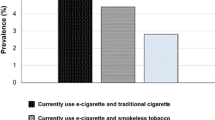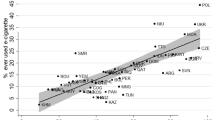Abstract
Background
Currently electronic cigarettes are becoming popular, especially among youth (middle and high school students). Their usage is being debated concerning their role in smoking cessation. The electronic cigarette, also known as e-cigarette, is an electronic nicotine delivery system. It is a mechanical device designed to mimic regular cigarettes, looks like conventional cigarette, delivers nicotine through inhaling vapors without burning tobacco. Globally, as well as in the US, tobacco smoking has been the leading cause of preventable death. In 2015, an estimated 5 million middle and high school students were users of all kinds of tobacco products in the USA. Out of which, 3 million students have experimented with e-cigarettes.
Objective
To assess the extent of e-cigarette experimenting among youth from 2011 to 2015 grade-wise and gender-wise. To analyze the 2015 data more extensively.
Methods
National Youth Tobacco Survey (NYTS) data is used from CDC, USA. Peer-reviewed articles from 2000 to 2016 were identified through electronic database Medline and Pub-Med on the electronic cigarettes, were reviewed and analyzed.
Results
The trend of experimenting with e-cigarettes at different ages and grades has been increasing steeply among youth. In the year 2015, about 45% of 12th graders experimented with e-cigarettes. Also, about 24% of females and 29% of male students have reported experimenting with e-cigarettes. Significantly, more Mexicans and Native Hawaiians, and fewer Asians tried e-cigarettes compared to the rest. There was no significant difference in experimenting with e-cigarettes among whites versus non-whites and African Americans versus non-African Americans.
Conclusions
Our findings emphasize the need to make policy makers and school administrators aware of the extent of usage of e-cigarettes, especially, among juniors and seniors. Since the prevalence of e-cigarette use is steeply increasing over the past years, proper intervention programs should be implemented in schools for the benefit of targeted youth.



Similar content being viewed by others
References
Caponnetto P, Campagna D, Cibella F, Morjaria JB, Caruso M, Russo C, Polosa R (2013) Efficiency and safety of an electronic cigarette (ECLAT) as tobacco cigarettes substitute: a prospective 12-month randomized control design study. PLoS One 8(6):e66317
CDC.gov (2014) Retrieved December 13, 2017, from https://www.cdc.gov/other/index.htm
CDC (2016) https://www.cdc.gov/tobacco/data_statistics/surveys/nyts/index.htmeferences. Accessed October 2016
Coleman BN, Apelberg BJ, Ambrose BK, Green KM, Choiniere CJ, Bunnell R, King BA (2014) Association between electronic cigarette use and openness to cigarette smoking among US young adults. Nicotine Tob Res. https://doi.org/10.1093/ntr/ntu211
Cahn Z, Siegel M (2011) Electronic cigarettes as a harm reduction strategy for tobacco control: a step forward or a repeat of past mistakes? J Public Health Policy 32(1):16–31
Cheng T (2014) Chemical evaluation of electronic cigarettes. Tob Control 23(suppl 2):ii11–ii17
Eissenberg T (2010) Electronic nicotine delivery devices: ineffective nicotine delivery and craving suppression after acute administration. Tob Control 19(87–88):2010
Farsalinos KE, Polosa R (2014) Safety evaluation and risk assessment of electronic cigarettes as tobacco cigarette substitutes: a systematic review. Ther Adv Drug Saf 5(2):67–86
Fairchild AL, Bayer R, Colgrove J (2014) The renormalization of smoking? E-Cigarettes and the tobacco “endgame”. N Engl J Med 370:293–295. https://doi.org/10.1056/NEJMp1313940. Accessed June 15, 2016
Grana RA, Ling PM (2014) “Smoking revolution”: a content analysis of electronic cigarette retail websites. Am J Prev Med 46(4):395–403
Garrett BE, Dube SR, Trosclair A, Caraballo RS, Pechacek TF, Centers for Disease Control and Prevention (CDC) (2008) Cigarette smoking: United States, 1965–2008. MMWR Surveill Summ 60(1):109–113
Goniewicz ML, Jakub K, Michal G, Leon K, Andrzej S, Jolanta K, Prokopowicz A et al (2013) Levels of selected carcinogens and toxicants in vapour from electronic cigarettes. Tob Control 23(2):133–139
Hartmann-Boyce J, McRobbie H, Bullen C, Begh R, Stead LF, Hajek P (2016) Electronic cigarettes for smoking cessation. Cochrane Database System Rev 2016(9), CD010216
Hajek P, Etter F, Benowitz N, Eissenberg T, McRobbie H (2014) Electronic cigarettes: review of use, content, safety, effects on smokers and potential for harm and benefit. Addiction 109(11):1801–1810
Kim HJ, Shin HS (2013) Determination of tobacco-specific nitrosamines in replacement liquids of electronic cigarettes by liquid chromatography-tandem mass spectrometry. J Chromatogr A 1291:48–55
National Youth Tobacco Survey (NYTS) (2016) https://www.cdc.gov/tobacco/data_statistics/surveys/nyts/index.htmeferences. Accessed March 03, 2017
NIDA Drug Abuse (2014) https://www.drugabuse.gov/publications/science-addiction/citations. Accessed March 03, 2017
Pepper JK, Brewer NT (2013) Electronic nicotine delivery system (electronic cigarette) awareness, use, reactions and beliefs: a systematic review. Tob Control 10.1136/tobaccocontrol-2013-051122
Richardson A Xiao H, Vallon DM (2012) Primary and dual users of cigars and cigarettes: profiles, tobacco use patterns and relevance to policy. Nicotine Tob Res 14(8):927–932
Singh T (2015) Tobacco use among middle and high school students: United States, 2011–2015. MMWR Morb Mortality Wkly Rep 65:361–367
Surgeon General (2014) The health consequences. https://www.surgeongeneral.gov/library/reports/50-years-of-progress. Accessed 03 Dec 2016
US Department of Health and Human Services (2004) The health consequences of smoking: a report of the Surgeon General. US Department of Health and Human Services, Centers for Disease Control and Prevention, National Center for Chronic Disease Prevention and Health Promotion, Office on Smoking and Health, Atlanta, GA
US Dept. of Health and Human Services (2014) The health consequences of smoking: 50 years of progress—a report of the Surgeon General. US Department of Health and Human Services, Centers for Disease Control and Prevention, National Center for Chronic Disease Prevention and Health Promotion, Office on Smoking and Health, Atlanta, GA. http://www.cdc.gov/tobacco/data_statistics/sgr/50th-anniversary/index.htm. Accessed 21 May 2015
Vardavas CI, Filippidis FT, Agaku (2015) Determinants and prevalence of e-cigarette use throughout the European Union: a secondary analysis of 26 566 youth and adults from 27 countries. Tob Control 24(5):442–448. https://doi.org/10.1136/tobaccocontrol-2013-05-051394
Yamin CK, Bitton A, Bates DW (2010) E-cigarettes: a rapidly growing Internet phenomenon. Ann Intern Med 153(9):607–609
Funding
There is no funding for this study.
Author information
Authors and Affiliations
Corresponding author
Ethics declarations
Conflict of interest
All authors declared that there is no conflict of interest.
IRB
Institutional review board approval has been obtained from University of Cincinnati.
Additional information
The original version of this article was revised: Due to the existence of another journal with the same name, the Publisher has added a subtitle, “From Theory to Practice.” Effective as of January 2018, the new title of this Journal is Journal of Public Health: From Theory to Practice.
Rights and permissions
About this article
Cite this article
Ali, S., King, K., Vidourek, R. et al. A study of electronic cigarette use among youth. J Public Health (Berl.) 26, 417–424 (2018). https://doi.org/10.1007/s10389-017-0880-6
Received:
Accepted:
Published:
Issue Date:
DOI: https://doi.org/10.1007/s10389-017-0880-6




